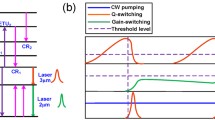Abstract
Pulsed lasers around 3μm have potential applications in the field of medicine, e.g. laser ablation of tissue, and in sensing and spectroscopy, e.g. for investigation of ultrashort processes. Fluoride fiber lasers in this range have the advantages of low thresholds and high efficiencies and can be cw pumped by laser diodes.
A mode-locked fiber laser at 2.7 μm was realized for the first time, utilizing the’flying-mirror’or kinematic mode-locking technique. The laser transition was 4I11/2 ->4I13/2 in Er3+, laser-diode pumped at 792 nm. The ZBLAN fiber doped with 1000 ppm Er3+ had a core diameter of 30 μm, a numerical aperture of 0.15 and a length of 134 cm. An input mirror with R @ 2.7 μm = 100% and T @ 792 nm = 80% and an output mirror with R @ 2.7 μm = 80% were butted to the fiber endfaces, forming the active resonator. The radiation diverging from the output endface of the fiber was collimated by an IRGN6 lens and led to an external mirror with R @ 2.7 μm > 98%, reflecting it into the active cavity. Power was coupled out of this external resonator by a 50% beamsplitter. The external mirror was mounted on a loudspeaker driven by a sine generator. The output radiation was focussed onto a fast InSb detector, the signal of which was preamplified and displayed on a 400 MHz oscilloscope. The response time of the detection setup was about 2.5 ns.
Moving the external mirror either manually or by the loudspeaker caused trains of pulses. Within each loudspeaker period several pulse trains occurred. No pulses were observed in the vicinity of the return points of the vibrating mirror. Each pulse train (typical length 5–10 μs) consisted of several hundreds of pulses. The pulse lengths were measured down to 3.5 ns and their fall times down to 2.5 ns, indicating that these measured values were detector resolution limited. The pulse repetition rate was 81 MHz, this representing approximately the roundtrip time of the active resonator. The pulses could be generated over a large range of loudspeaker frequencies, amplitudes and pump powers. For pulse generation it was favourable to have the greatest possible velocity of the external mirror. Average output powers exceeding 1 mW at a launched power of 190 mW could be measured.
The mechanism of pulse generation is not yet clear. A possible explanation could be that the mirror translation causes frequency shifts due to the doppler effect, hence exchanges energy between adjacent modes and locks them after several roundtrips.
Similar content being viewed by others
Author information
Authors and Affiliations
Editor information
Editors and Affiliations
Rights and permissions
Copyright information
© 1995 Springer Science+Business Media Dordrecht
About this chapter
Cite this chapter
Frerichs, C. (1995). Mode-Locking of a 2.7 μm Erbium-Doped Fluoride Fiber Laser. In: Soares, O.D.D. (eds) Trends in Optical Fibre Metrology and Standards. NATO ASI Series, vol 285. Springer, Dordrecht. https://doi.org/10.1007/978-94-011-0035-9_62
Download citation
DOI: https://doi.org/10.1007/978-94-011-0035-9_62
Publisher Name: Springer, Dordrecht
Print ISBN: 978-94-010-4020-4
Online ISBN: 978-94-011-0035-9
eBook Packages: Springer Book Archive




